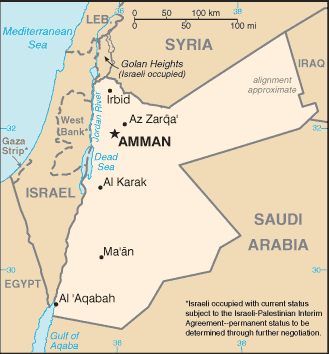|
Jordan
|

|
Capital: Amman
Population: 10,101,694
Brief History of Jordan:
Jordan was first settled by the Amorites in 2000 BC. Many other ancient nations and empires would settle or conquer the land over the years. These included the Hittites, Egyptians, Israelites, Assyrians, Babylonians, Persians, Greeks and Romans.
One of the most notable Jordanian civilizations was the Nabatean Kingdom. They built the famous capital city at Petra which became a major trade center for the region. They also developed the North Arabic Script which would later become the Modern Arabic script. The Nabatean Empire controlled much of current Jordan as well as surrounding lands at its peak. It was later taken over by the Persian Empire and eventually the Roman Empire.
In 1516 Jordan became part of the Ottoman Empire. It would stay a part of the Ottoman Empire until the end of World War I when it would be awarded to the United Kingdom. The British created the Emirate of Transjordan ruled by Prince Abdullah, but under British rule. In 1946, Jordan became an independent country.
The Geography of Jordan
Total Size: 92,300 square km
Size Comparison: slightly smaller than Indiana
Geographical Coordinates: 31 00 N, 36 00 E
World Region or Continent: Middle East
General Terrain: mostly desert plateau in east, highland area in west; Great Rift Valley separates East and West Banks of the Jordan River
Geographical Low Point: Dead Sea -408 m
Geographical High Point: Jabal Ram 1,734 m
Climate: mostly arid desert; rainy season in west (November to April)
Major cities: AMMAN (capital) 1.088 million (2009), Az Zarqa, Irbid
The People of Jordan
Type of Government: constitutional monarchy
Languages Spoken: Arabic (official), English widely understood among upper and middle classes
Independence: 25 May 1946 (from League of Nations mandate under British administration)
National Holiday: Independence Day, 25 May (1946)
Nationality: Jordanian(s)
Religions: Sunni Muslim 92%, Christian 6% (majority Greek Orthodox, but some Greek and Roman Catholics, Syrian Orthodox, Coptic Orthodox, Armenian Orthodox, and Protestant denominations), other 2% (several small Shi'a Muslim and Druze populations) (2001 est.)
National Symbol: eagle
National Anthem or Song: As-salam al-malaki al-urdoni (Long Live the King of Jordan)
Economy of Jordan
Major Industries: textiles, phosphate mining, fertilizers, pharmaceuticals, petroleum refining, cement, potash, inorganic chemicals, light manufacturing, tourism
Agricultural Products: wheat, barley, citrus, tomatoes, melons, olives; sheep, goats, poultry
Natural Resources: phosphates, potash, shale oil
Major Exports: clothing, phosphates, fertilizers, potash, vegetables, manufactures, pharmaceuticals
Major Imports: crude oil, textile fabrics, machinery, transport equipment, manufactured goods
Currency: Jordanian dinar (JOD)
National GDP: $36,940,000,000
** Source for population (2012 est.) and GDP (2011 est.) is CIA World Factbook.
Back to Geography Home Page
